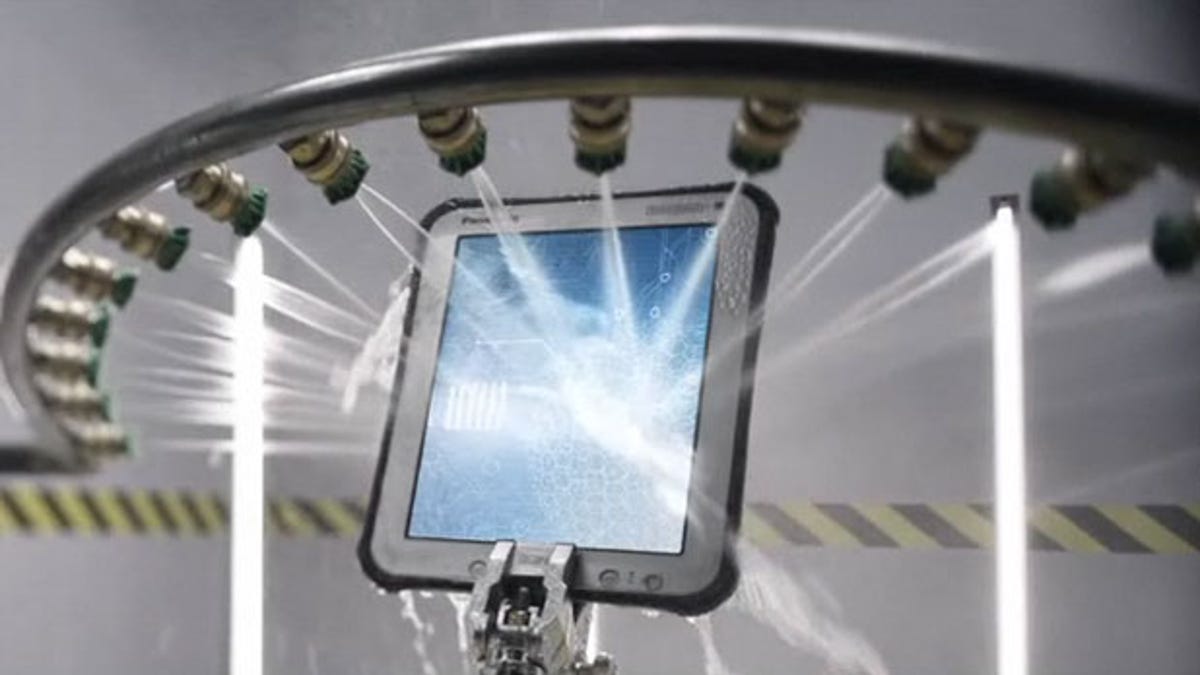Panasonic reveals industrial-strength Android tablets
The 10-inch and 7-inch Toughpads, due in 2012, are designed to withstand water, heat, grit, and shock. Let's hope mainstream models follow their lead.

Panasonic has some good news for the kinds of people who worry about using their tablets in the rain, dropping them on a concrete floor, or using them outdoors in the desert.
The company announced yesterday that it plans to sell two models of rugged Android tablets under the Toughpad brand name starting in 2012. The 10-inch, $1,299 Toughpad A1 will arrive first, in the spring, and the 7-inch Toughpad B1 later in the year.
Panasonic isn't aiming the Toughpads at the average consumer, but rather to various business users such as utility crews on the road, military staff in combat situations, or doctors making their rounds. It's a tablet extension of the approach the company already takes with its Toughbook line of rugged PCs.
But I still see the products as good news for average consumers as durability becomes a selling point. Gorilla Glass has meant that buyers of higher-end smartphones don't have to worry about screens scratched by keys and coins, and an ever-broader array of cameras and videocameras are shockproof and waterproof. Durability adds complexity and expense to a device, but it's a feature that I think customers will appreciate and pay for at least in moderate doses.
And even in Panasonic doesn't expect mainstream customers to be the core market for the devices, it's clearly still hoping the Toughbook line will improve the company's image. In a Toughpad promotional video, Panasonic derides the mainstream competition as "just a bunch of toys."
Rugged computers often take a hit compared to mainstream models, for example because the requirement to run in hot conditions demands a slower, cooler-running processor. But tablets, which already are designed to operate without a chip cooling fan, might not be at such a competitive disadvantage.
Indeed, the Panasonic Toughpad specs look reasonably competitive by today's standards, though it'll look a generation behind by the time it actually arrives in the fast-moving market that will see quad-core chips and Android 4.0 aka Ice Cream Sandwich arrive next year.
Among the Toughbook A1's mainstream specs: a 1.2GHz dual-core processor; Android 3.2 aka Honeycomb; a "daylight-readable," LED-backlit, 1024x768 touchscreen display; 1GB of DDR2 memory; options for WiMax or LTE 4G wireless networking or more conventional 3G networking; a front-facing 2-megapixel camera and rear-facing 5-megapixel camera with an LED flash; ports for micro USB, micro SDHC, and HDMI; and a 33.9 watt-hour lithium-ion battery. It measures 10.5x8.3x0.67 inches and weighs 2.1 pounds.
The novel specs come later, though: operating temperatures between 14 degrees and 122 degrees Fahrenheit, drop-test rating to 4 feet, a magnesium alloy chassis with elastomer bumpers on the corners, hardware security features, the ability to withstand thermal shocks from rapid changes in temperature, a protected screen, port covers to keep out dust, vibration resistance, a field-replaceable battery, and compliance with the MIL-STD-810G military standard for environmental engineering. It's also got a stylus, a good feature for precision input.
With a price that's hundreds of dollars more than a conventional tablet, mainstream customers won't pay for the Toughpad. I wouldn't be surprised also if its daylight-readable, anti-glare screen doesn't look as good for those who mostly play games or videos indoors.
But speaking as a person whose iPad is afflicted with a big dent in one corner and whose Samsung Galaxy Tab's screen is popping out of its chassis, I do hope at least some of the Toughpad ethos spreads to the mainstream.
Via Android Guys.

